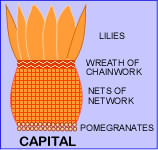Author: Larry Wood, Released
December 15, 2017
 8.
Two bronze pillars 18 cubits tall marked the entrance of Solomon's
Temple (1 Ki 7:15-21; 2 Ch 3:15-17;
4:12-13). The pillars were carried away into Babylon (Jer
52:17-23).
8.
Two bronze pillars 18 cubits tall marked the entrance of Solomon's
Temple (1 Ki 7:15-21; 2 Ch 3:15-17;
4:12-13). The pillars were carried away into Babylon (Jer
52:17-23). 3. The entrance to Solomon's
Temple was marked off by two bronze pillars to designate the way
to Eternal Life and fellowship with God (1 Ki 7:15-21). Bronze symbolizes
judgment, corresponding to Judgment for sins and the redemption
solution. Outside the pillars was the way of
reversionism and eternal judgment.
3. The entrance to Solomon's
Temple was marked off by two bronze pillars to designate the way
to Eternal Life and fellowship with God (1 Ki 7:15-21). Bronze symbolizes
judgment, corresponding to Judgment for sins and the redemption
solution. Outside the pillars was the way of
reversionism and eternal judgment.
 1. Two
large cast bronze, or brass, pillars stood at the entrance of
Solomon's Temple to mark the way to Eternal Life and fellowship
with God (1 Ki 7:15-21; Jn 14:6; Matt 7:13-14).
1. Two
large cast bronze, or brass, pillars stood at the entrance of
Solomon's Temple to mark the way to Eternal Life and fellowship
with God (1 Ki 7:15-21; Jn 14:6; Matt 7:13-14). b. The round central part with netting symbolized the skull
and also a bulb from which the lilies grew.
b. The round central part with netting symbolized the skull
and also a bulb from which the lilies grew.Author: Larry Wood, Released
December 15, 2017
| Top | Author | Comments | Home |